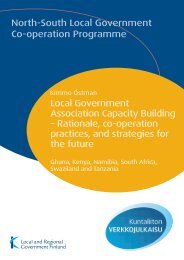E-READINESS QUESTIONNAIRE FOR NORTH ... - Kunnat.net
E-READINESS QUESTIONNAIRE FOR NORTH ... - Kunnat.net
E-READINESS QUESTIONNAIRE FOR NORTH ... - Kunnat.net
Create successful ePaper yourself
Turn your PDF publications into a flip-book with our unique Google optimized e-Paper software.
26<br />
It is important to note, however, that OSS is never ‘free.’ While there may not be<br />
an initial fee associated with an open source license, there are long-term costs associated<br />
with support and management. Given that many OSS products are continually<br />
evolving, specialized knowledge is needed for ongoing maintenance and support. Specifi<br />
c applications can also lose favor over time, meaning that developers may move on<br />
to newer technologies and may stop supporting old versions of programs. These factors<br />
introduce risk into the use of OSS applications. In comparison, proprietary software<br />
has higher initial licensing, software support, and update fees, but support is generally<br />
more stable for such products. Further research is required on how the costs of OSS<br />
compare to the costs of proprietary software in a developing country context.<br />
There are many open source templates, software applications, and tools available<br />
for building websites and ‘interact’ and ‘transact’ applications. Open source software<br />
providers are often non-profi t organizations and websites are their primary vehicle for<br />
distributing products.<br />
2.13 Measuring E-Government<br />
Reliable and relevant E-government measurement can offer crucial signposts to point<br />
policy makers and practitioners in the right direction. Before defi ning an E-Government<br />
for development strategy or plan of action, a thorough analysis is required of the<br />
existing environment in which E-Government will be implemented An e-Readiness assessment<br />
is a useful tools for determining a country’s “starting point” in terms of ICT,<br />
and constitutes the initial phase of the ICT strategic planning process for any government<br />
or community 28 .<br />
E-Government readiness: understanding key fact ors<br />
E-Readiness is a term used to assess the preparedness of a community to participate in<br />
the global information society and digital economy. The level of e-Readiness is gauged<br />
by assessing a community’s maturity across a series of ICT indicators that are considered<br />
key in facilitating national development and delivering broad ICT-related benefi<br />
ts29 .<br />
Understanding a nation’s level of e-Readiness provides an excellent platform for<br />
launching any national ICT endeavour, and also provides the all-important baseline<br />
for measuring progress as the national ICT agenda advances.<br />
28 Plan of Action for E-Government Development, Government of Italy, Ministry of Innovation and Technology & United Nations<br />
Department of Economics and Social Affairs, 2002 http://unpan1.un.org/intradoc/groups/public/documents/un/unpan010301.pdf<br />
29 Belize National ICT Policy, 2007, http://www.belize-glessimaresearch.org/downloads/e-readiness_assessment%20_sept2007.<br />




